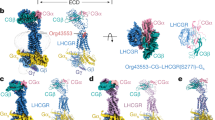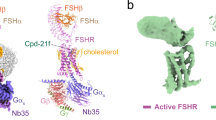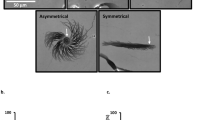Abstract
The chick oviduct progesterone receptor has been characterised and purified by us1–3and shown to consist of a mixture of two hormone-binding proteins4,5. These two proteins have equivalent ligand-binding sites, to which progesterone and other progestational steroids bind with high affinity (kdiss = 10−9 M)6,7. Due to the noncovalent nature of this interaction, analysis of the proteins in denaturing or nonequilibrium conditions has always been hampered by ligand–protein dissociation during the experiments (t1/2 = 12 h at 0 °C, 25 min at 37 °C)6. Efforts to use covalent attachment of steroids by alkylation or photoactivation have been largely unsuccessful, both for this protein and for other receptors8. However, covalent labelling of steroid isomerases9 and an androgen-binding protein10 has been obtained in reasonable yields using photoactivation of keto steroids containing multiple double bonds in conjugation with the ring-A ketone. We now report the first successful covalent attachment of a radiolabelled steroid to its receptor protein. The ligand chosen was a synthetic progestin, 17α,21-dimethyl-19-nor-pregn-4,9-diene-3,20-dione (R5020; Roussel-Uclaf)11. R5020 is available as the tritiated 17α-methyl derivative (≥50 Ci mmol−1) and has been used extensively for measuring mammalian progesterone receptors in normal12,13 and neoplastic tissues14,15. This steroid was chosen for the photoaffinity study because its absorption maximum is at 320 nm, thereby allowing its activation by UV light at wavelengths above 300 nm, where protein damage would be minimised. The method should be generally applicable to other progestin receptors.
This is a preview of subscription content, access via your institution
Access options
Subscribe to this journal
Receive 51 print issues and online access
$199.00 per year
only $3.90 per issue
Buy this article
- Purchase on Springer Link
- Instant access to full article PDF
Prices may be subject to local taxes which are calculated during checkout
Similar content being viewed by others
References
Kuhn, R. W., Schrader, W. T., Smith, R. G. & O'Malley, B. W. J. biol. Chem. 250, 4220–4228 (1975).
Schrader, W. T., Kuhn, R. W. & O'Malley, B. W. J. biol. Chem. 252, 299–307 (1977).
Coty, W. A., Schrader, W. T. & O'Malley, B. W. J. Steroid Biochem. 10, 1–12 (1979).
Schrader, W. T. & O'Malley, B. W. J. biol. Chem. 247, 51–59 (1972).
Birnbaumer, M. E., Schrader, W. T. & O'Malley, B. W. Biochem. J. 181, 201–213 (1979).
Hansen, P. E., Schrader, W. T. & O'Malley, B. W. J. Steroid Biochem. 7, 723–732 (1976).
Smith, H. E. et al. J. biol. Chem. 249, 5924–5932 (1974).
Katzenellenbogen, J. H., Johnson, H. J. Jr, Carlsen, K. E. & Myers, H. N. Biochemistry 13, 2986–2994 (1974).
Benisek, W. T. Meth. Enzym. 46, 469–479 (1977).
Taylor, C. A., Smith, H. E. & Danzo, B. J. Proc. natn. Acad. Sci. U.S.A. (in the press).
Philibert, D. & Raynaud, J. P. Steroids 22, 89–98 (1973).
Walters, M. R. & Clark, J. H. Endocrinology 105, 382–386 (1979).
Horwitz, K. B. & McGuire, W. L. Steroids 25, 497–505 (1975).
Goral, J. E. & Wittliff, J. L. Cancer Res. 36, 1886–1893 (1976).
Lippman, M., Huff, K., Bolan, G. & Neifeld, J.P. in Progesterone Receptors in Normal and Neoplastic Tissues (eds McGuire, W. L., Raynaud, J. P. & Baulieu, E. E.) 193–210 (Raven, New York, 1977).
Schrader, W. T. Meth. Enzym. 36, 187–211 (1975).
Laemmli, U. K. Nature 227, 680–685 (1970).
Schrader, W. T. & O'Malley, B. W. Cancer Res. 38, 4199–4203 (1978).
Vedeckis, W. V., Freeman, M. R., Schrader, W. T. & O'Malley, B. W. Biochemistry (in the press).
Vedeckis, W. V., Schrader, W. T. & O'Malley, B. W. Biochemistry (in the press).
Author information
Authors and Affiliations
Rights and permissions
About this article
Cite this article
Dure, L., Schrader, W. & O'Malley, B. Covalent attachment of a progestational steroid to chick oviduct progesterone receptor by photoaffinity labelling. Nature 283, 784–786 (1980). https://doi.org/10.1038/283784a0
Received:
Accepted:
Issue Date:
DOI: https://doi.org/10.1038/283784a0
This article is cited by
-
Association of thyroid hormone receptors with chromatin
Molecular and Cellular Biochemistry (1983)
-
Photoinduced bonding of endogenous ecdysterone to salivary gland chromosomes of Chironomus tentans
Chromosoma (1981)
Comments
By submitting a comment you agree to abide by our Terms and Community Guidelines. If you find something abusive or that does not comply with our terms or guidelines please flag it as inappropriate.



